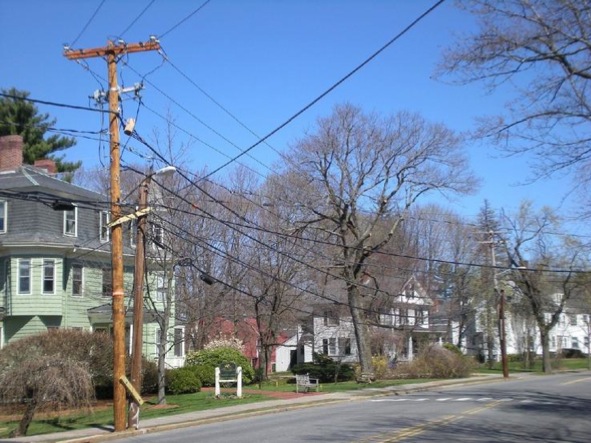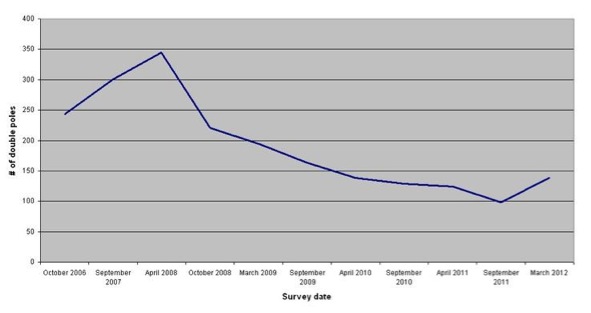Survey shows increase in double poles in Lexington
By Ben Aaronson/baaronson@wickedlocal.com
Wicked Local Lexington
Posted Apr 26, 2012
Lexington — On Oct. 30, 2006, Peter Bowman, vice president of external affairs for Verizon, told the Board of Selectmen his company was committed to addressing a backlog of double utility poles in town within six months. Nearly six years later, Lexington's Electric Utility Committee has found Verizon has only reduced the total number of double poles by about 43 percent.

Two double poles at 2027 and 2013 Massachusetts Ave. in Lexington.
A double pole refers to a support pole placed against an existing utility pole as a means of stabilizing the structure, often to support the weight of additional equipment. With up to four utilities attached to each pole, removing a double pole requires each co-locator to come out separately and move their wires from the old to the new pole. In Lexington, Verizon coordinates that work.
According to a recent survey by the committee, as of March 30, there were 138 double poles in Lexington, a net increase of 40 poles since the last committee’s last survey in September 2011.

Tracking the number of double poles in Lexington over time, according to biannual surveys conducted by the Lexington Electric Utility Committee dating back to October 2006.
Committee member Patrick Mehr said he has been frustrated both by the lack of progress and the lack of meaningful responses from Verizon executives to his repeated inquiries about the double pole backlog.
“These are multi-billion dollar corporations whose chief executives make multi-millions of dollars a year, and they don’t even care to explain why what they told selectmen would happen in six months six years ago has still not happened. Are they above the law?” Mehr said. “I think the public deserves an answer.”
Mehr also pointed to the utilities’ Pole Lifetime Management (PLM) database, which he said, after more than eight years, remains chronically inaccurate and incomplete. According to Mehr, PLM misses about 30 percent of the 138 double poles his committee cataloged in the most recent survey.
By the numbers: Double poles
138 double poles in Lexington as of March 30, 2012
8 double poles removed since September 2011
48 double poles added since September 2011
90 days a utility company has to remove a double pole, according to state law
65% of existing double poles that have been up for more than 90 days
Source: Lexington Electric Utility Committee
Verizon spokesman Phil Santoro said his company has been doing regular pole work in Lexington, removing 77 double poles in the past year. According to Santoro, Verizon removed 10,000 double poles statewide last year, but during the same span 9,000 new double poles were created as a result of electric power upgrades and road construction projects.
“Verizon, other utilities, cable companies and municipalities are working hard and making very good progress on double poles,” Santoro wrote in an email. “The maintenance of the PLM database is a shared responsibility for each utility, attachee and community.”
Santoro did not respond by press time to follow-up questions about the accuracy of the PLM database.
Legislative efforts
Massachusetts state law (Chapter 164, Section 34B) requires utility companies to remove an existing pole within 90 days of installation of a new pole on the site, except in cases of lengthy commercial or industrial construction projects, where companies have six months to remove the offending pole. There is currently no penalty for violating these requirements.
According to the Electric Utility Committee’s survey, of the existing double poles in Lexington, at least 65 percent have been there for more than 90 days, including many that have been up for several years.
Mehr said Verizon’s actions prove “that the utilities simply don’t care. They feel they can simply look the other way. It’s our estimation they will continue to do so until the state creates a schedule of fines.”
About a dozen bills currently up for consideration by the state Legislature would assess fines of varying amounts for continued non-compliance with double pole regulations. A bill filed by Rep. Jonathan Hecht, D-Watertown, also would direct state regulators to assess progress on removing double poles and suggest further solutions.
Mehr said legislation should impose a graduated schedule of fines, which utilities should not be able to pass along to consumers by raising rates. Mehr said pole owners should, however, be empowered to charge tenants for delaying the removal process.
“If these three things happen,” he said, “then it seems clear to us that the double pole problem would go away.”
State Rep. Kate Hogan, D-Stow, headed a subcommittee that looked into the issue this spring. Hogan alluded to a lack of reliable information on the extent of double poles.
"You can't manage something if you can't measure it," she said recently.
Hogan said her group consulted with utilities, municipal officials and other stakeholders on possible solutions recently and made recommendations to Rep. John Keenan, D-Salem, House chairman of the Joint Committee on Telecommunications, Utilities and Energy.
Hogan’s aide Scott Kjellberg said the subcommittee is waiting for approval from the chairmen of the joint committee before releasing its recommendations. Kjellberg said a final recommendation from the joint committee is expected by May 1.
Mehr said the Electric Utility Committee plans to continue pushing the double pole issue for as long as it takes.
“It makes the town ugly and in some cases dangerous,” he said. “We will not let go of this until it is resolved.”
David Riley contributed to this article.
